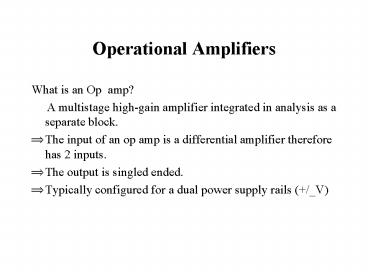Operational Amplifiers PowerPoint PPT Presentation
1 / 18
Title: Operational Amplifiers
1
Operational Amplifiers
- What is an Op amp?
- A multistage high-gain amplifier integrated
in analysis as a separate block. - The input of an op amp is a differential
amplifier therefore has 2 inputs. - The output is singled ended.
- Typically configured for a dual power supply
rails (/_V)
2
Op Amps (differential input)
- Differential Amplifier considerations
- 2 NPN, 2 PNP or 2 FETs (matched pairs)
- Inherent symmetry
- Current stability
- Input impedance
- Beta
3
Op amps (differential input)
- D.C. considerations of Diff Amp
- Emitter type bias
- Total current ( )
- Input offset current and voltage
- Will both transistors have identical
characteristics? - - Differences in junction characteristics
will develop variations in base and collector
currents. Because the diff amp amplifies the
difference potential it sees between the two
inputs so too will these unwanted differences be
amplified.
4
Op Amps (differential input)
- The D.C. performance of an op amp can be
measured. - Input offset current (difference between both
base currents) - Output offset current )difference between two
collector currents) - Output offset voltage (difference between two
collector voltages) - The amount of voltage required to offset the base
voltage difference is called the input offset
voltage. - Ideal op amp will have all three at 0.
5
IC2
IC1
6
Op Amps (differential amplifiers)
- A.C. CONSIDERATIONS
- Four signal circuit configurations
- Differential input, differential output
- Differential input, single-ended output (most
common) - Single-ended input, differential output
- Single-ended input, single-ended output
7
Op Amps (differential amplifier)
- A.C. CONSIDERATIONS
- Assume a single-ended input and single-ended
output - The voltage output of the Q2 collector is in
phase with the Q1 input. - The voltage output of Q1 is out of phase with the
Q1 input. - The voltage seen across the two collectors will
be 180 degrees apart. If we take the differential
output we observe a doubling of the signal.
8
Vout 2
Vout 1
9
(No Transcript)
10
Op Amps (differential amplifier)
- COMMON MODE
- In phase signals are common-mode signals
- Ideal op amp will suppress common-mode signals
entirely with a common mode gain of 0 - A real op amp will not display perfect common
mode rejection - Dominant causes of error are
- 1. Resistor tolerance variations.
- 2. Transistor parameter deviation..
11
Op Amps (differential amplifier)
- A.C. CONSIDERATIONS
- Assume a single-ended input and a single ended
output - Voltages at both inputs that are in phase will
develop out of phase collector outputs that when
added will be 0. (see diagram) - In summary, a differential amplifier suppresses
in phase input signals and elevates out of phase
input signals.
12
Op Amps
- Common applications
- Inverting amplifier
- Non inverting amplifier
- Comparators
- Voltage level detectors
- Instrumentation amplifiers.
13
V
Vout
Vin-
Vin
-V
14
Vcc
Vin-
Vout
Vin
-VEE
15
Op Amps
- Attributes of an ideal op amp
- Infinite gain
- Unlimited bandwidth
- Infinite input impedance
- Very little output impedance
16
Op Amps
- Open loop versus closed loop configuration
- gtOpen loop has infinite gain (no feedback)
therefore it is suitable for comparator or
voltage detection applications. - Why? Output can drive to a desired
saturation level depending on events observed at
the input. - gt Closed loop uses negative feedback to control
gain at the cost of bandwidth.
17
Inverting Amplifier
VCC
-VEE
18
Non Inverting Amplifier
VCC
-VEE
Virtual ground

